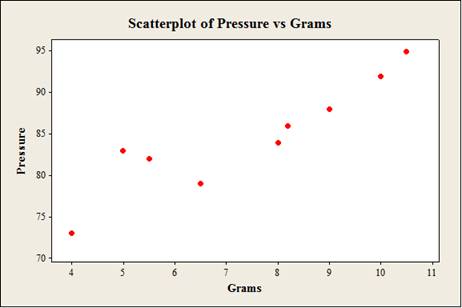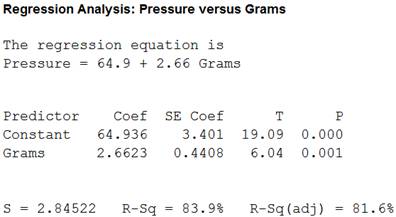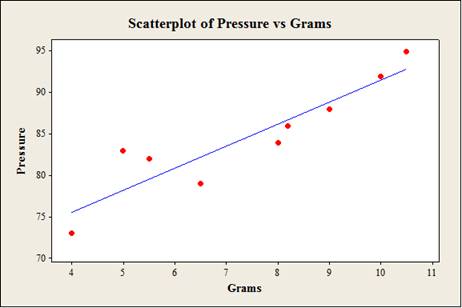
Concept explainers
For Exercises 1 through 7, do a complete
a. Draw the
b. Compute the value of the
c. Test the significance of the correlation coefficient at α = 0.01, using Table I.
d. Determine the regression line equation if r is significant.
e. Plot the regression line on the scatter plot, if appropriate.
f. Predict y′ for a specific value of x, if appropriate.
6. Protein and Diastolic Blood Pressure A study was conducted with vegetarians to see whether the number of grams of protein each ate per day was related to diastolic blood pressure. The data are given here. If there is a significant relationship, predict the diastolic pressure of a vegetarian who consumes 8 grams of protein per day. (This information will be used for Exercises 10 and 12.)

a.
To construct: The scatterplot for the variables the number of grams of protein and the diastolic blood pressure.
Answer to Problem 10.1.6RE
Output using the MINITAB software is given below:

Explanation of Solution
Given info:
The data shows the number of grams of protein (x) and the diastolic blood pressure (y) values.
Calculation:
Step by step procedure to obtain scatterplot using the MINITAB software:
- Choose Graph > Scatterplot.
- Choose Simple and then click OK.
- Under Y variables, enter a column of Pressure.
- Under X variables, enter a column of Grams.
- Click OK.
b.
To compute: The value of the correlation coefficient.
Answer to Problem 10.1.6RE
The value of the correlation coefficient is 0.916.
Explanation of Solution
Calculation:
Correlation coefficient r:
Software Procedure:
Step-by-step procedure to obtain the ‘correlation coefficient’ using the MINITAB software:
- Select Stat > Basic Statistics > Correlation.
- In Variables, select x and y from the box on the left.
- Click OK.
Output using the MINITAB software is given below:

From the MINITAB output, the value of the correlation is 0.916.
c.
To test: The significance of the correlation coefficient at
Answer to Problem 10.1.6RE
The conclusion is that, there is a linear relation between the number of grams of protein and the diastolic blood pressure.
Explanation of Solution
Given info:
The level of significance is
Calculation:
The hypotheses are given below:
Null hypothesis:
That is, there is no linear relation between the number of grams of protein and the diastolic blood pressure.
Alternative hypothesis:
That is, there is a linear relation between the number of grams of protein and the diastolic blood pressure.
The sample size is 9.
The formula to find the degrees of the freedom is
That is,
From the “TABLE –I: Critical Values for the PPMC”, the critical value for 7 degrees of freedom and
Rejection Rule:
If the absolute value of r is greater than the critical value then reject the null hypothesis.
Conclusion:
From part (b), the value of r is 0.916 that is the absolute value of r is 0.916.
Here, the absolute value of r is greater than the critical value
That is,
By the rejection rule, reject the null hypothesis.
There is a sufficient evidence to support the claim that “there is a linear relation between the number of grams of protein and the diastolic blood pressure.
d.
To find: The regression equation for the given data.
Answer to Problem 10.1.6RE
The regression equation for the given data is
Explanation of Solution
Calculation:
Regression:
Software procedure:
Step by step procedure to obtain the regression equation using the MINITAB software:
- Choose Stat > Regression > Regression.
- In Responses, enter the column of Pressure.
- In Predictors, enter the column of Grams.
- Click OK.
Output using the MINITAB software is given below:

Thus, regression equation for the given data is
e.
To construct: The scatterplot for the variables the speed and time with regression line.
Answer to Problem 10.1.6RE
Output using the MINITAB software is given below:

Explanation of Solution
Calculation:
Step by step procedure to obtain scatterplot using the MINITAB software:
- Choose Graph > Scatterplot.
- Choose with line and then click OK.
- Under Y variables, enter a column of Pressure.
- Under X variables, enter a column of Grams.
- Click OK.
f.
To obtain: The predicted value of the diastolic pressure of a vegetarian who consumes 8 grams of protein per day.
Answer to Problem 10.1.6RE
The predicted value of the diastolic pressure of a vegetarian is 86.232.
Explanation of Solution
Calculation:
Thus, regression equation for the given data is
Substitute x as 8 in the regression equation
Thus, the predicted value of the diastolic pressure of a vegetarian is 86.232.
Want to see more full solutions like this?
Chapter 10 Solutions
Connect hosted by ALEKS Access Card 52-Week for Elementary Statistics: A Step by Step Approach
- A marketing agency wants to determine whether different advertising platforms generate significantly different levels of customer engagement. The agency measures the average number of daily clicks on ads for three platforms: Social Media, Search Engines, and Email Campaigns. The agency collects data on daily clicks for each platform over a 10-day period and wants to test whether there is a statistically significant difference in the mean number of daily clicks among these platforms. Conduct ANOVA test. You can provide your answer by inserting a text box and the answer must include: also please provide a step by on getting the answers in excel Null hypothesis, Alternative hypothesis, Show answer (output table/summary table), and Conclusion based on the P value.arrow_forwardA company found that the daily sales revenue of its flagship product follows a normal distribution with a mean of $4500 and a standard deviation of $450. The company defines a "high-sales day" that is, any day with sales exceeding $4800. please provide a step by step on how to get the answers Q: What percentage of days can the company expect to have "high-sales days" or sales greater than $4800? Q: What is the sales revenue threshold for the bottom 10% of days? (please note that 10% refers to the probability/area under bell curve towards the lower tail of bell curve) Provide answers in the yellow cellsarrow_forwardBusiness Discussarrow_forward
- The following data represent total ventilation measured in liters of air per minute per square meter of body area for two independent (and randomly chosen) samples. Analyze these data using the appropriate non-parametric hypothesis testarrow_forwardeach column represents before & after measurements on the same individual. Analyze with the appropriate non-parametric hypothesis test for a paired design.arrow_forwardShould you be confident in applying your regression equation to estimate the heart rate of a python at 35°C? Why or why not?arrow_forward
 Glencoe Algebra 1, Student Edition, 9780079039897...AlgebraISBN:9780079039897Author:CarterPublisher:McGraw Hill
Glencoe Algebra 1, Student Edition, 9780079039897...AlgebraISBN:9780079039897Author:CarterPublisher:McGraw Hill Functions and Change: A Modeling Approach to Coll...AlgebraISBN:9781337111348Author:Bruce Crauder, Benny Evans, Alan NoellPublisher:Cengage Learning
Functions and Change: A Modeling Approach to Coll...AlgebraISBN:9781337111348Author:Bruce Crauder, Benny Evans, Alan NoellPublisher:Cengage Learning Trigonometry (MindTap Course List)TrigonometryISBN:9781337278461Author:Ron LarsonPublisher:Cengage Learning
Trigonometry (MindTap Course List)TrigonometryISBN:9781337278461Author:Ron LarsonPublisher:Cengage Learning
 Big Ideas Math A Bridge To Success Algebra 1: Stu...AlgebraISBN:9781680331141Author:HOUGHTON MIFFLIN HARCOURTPublisher:Houghton Mifflin Harcourt
Big Ideas Math A Bridge To Success Algebra 1: Stu...AlgebraISBN:9781680331141Author:HOUGHTON MIFFLIN HARCOURTPublisher:Houghton Mifflin Harcourt





